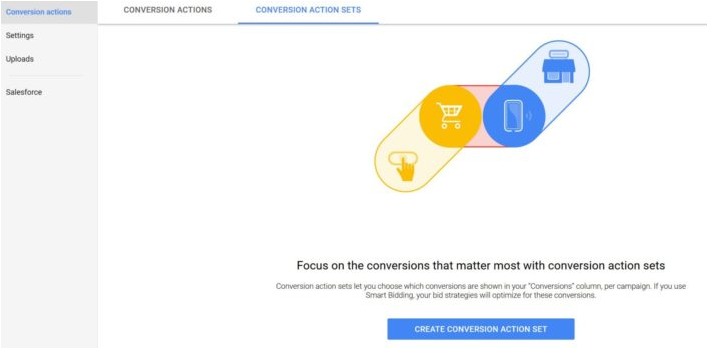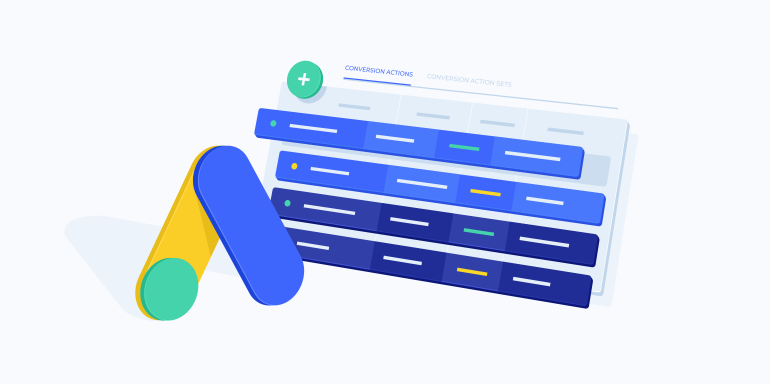- What is conversion tracking?
- Google Ads Campaign Level Conversions
- 2 Main benefits
- 7 Most important things to know
- Use with different campaign goals
- Creating multiple accounts not required
- Optimize for multiple conversion actions
- Expect a slow down in delivery
- Conversion rates may decrease
- CPA will likely increase
- Experiment first
- Conclusion: gain more control
As consumer journeys become increasingly complex, it’s paramount advertisers scale their efforts with automated solutions. Businesses across all industries have been using Google’s Smart Bidding options to set more precise bids tailored to every auction. In fact, over 70% of all advertisers use Google Ads automated bidding today.
While Smart Bidding has helped advertisers drive better performance, there was still the need for more flexibility and customizations to reach specific business goals. So earlier in 2019, Google announced several new bidding innovations — one of which went live across all accounts on June 6th: campaign level conversions.
Before we cover the details of that, let’s review the basics of Google Ads conversion tracking.
What is conversion tracking and why is it necessary?
Conversion tracking helps you improve success in digital advertising because it allows you to identify and measure valuable user actions (purchases, downloads, sign ups, phone calls, etc.) after interacting with your ad.
With Google conversion tracking, advertisers provide Google’s algorithm with the information it requires (either through Google Analytics or tracked via the Google Ads pixel) to understand what drives success in an account:
![]()
Advertisers can add as many conversion actions as they find valuable, and Google will record a conversion each time a user completes one of those actions. As an account collects conversion data, the algorithm learns more about these successful signals and automatically optimizes your ad delivery accordingly.
While conversion tracking has always been critical to a successful advertising account, there’s been a glaring missing piece: the ability to tell Google which conversion action is most important to a given campaign.
That’s where the new campaign level conversions setting comes in.
What is the Google Ads Campaign Level Conversion setting?
This new setting lets you override the account-level setting and specify conversion actions for a particular campaign, or group of campaigns. Meaning, you can now choose which conversion actions to include in the “Conversions” column at the campaign level, and not just the account level:

The 2 main benefits for advertisers
More control over which conversions show up in the “Conversions” column for each campaign
Selecting distinct conversion actions for your campaign provides more granular control over which conversions show up for each of your campaigns.
This level of control is especially useful if you have campaigns:
- with separate marketing budgets targeted at different actions
- in the same conversion scope when using cross-account conversion tracking
More data organization based on specific campaign goals vs. overall account goals
With account level conversions, all conversion actions in a given account combine to populate the conversion metrics. However, with the new setting, Google lets advertisers specify which action(s) to populate the conversion data from.
So, not only does it give Google more information about which conversion actions are most relevant to track and optimize. It also gives advertisers the ability to see their data more organized to notify Google what metrics are most important for their business goals.
7 Most important things to know about campaign level conversions
1. Useful for accounts with clearly differentiated campaign goals
It’s best practice to use campaign level conversions when your campaigns aim to capture different conversion types or goals (e.g., those representing different lines of business or distinct marketing budgets).
There’s an exception, though: If you have different conversion types setup that are valuable to your business across all campaigns in your account.
In this case — instead of using the campaign level conversion setting — report each action with different values in the “Conversions” column at the account-level, and use Target ROAS or Maximize Conversion Value bidding strategy. This way, each action is optimized effectively without any data loss.
Example
Say you sell both shoes and clothing on your website, with several campaigns targeted at each audience, and each one with different conversion actions. You might consider using the new setting to include only shoe purchases on your shoe campaigns and only clothing purchases on your clothing campaigns. This may make logical sense but isn’t recommended. Here’s why…
It’s likely that customers looking for shoes initially end up clicking an ad that leads to your website where they find clothing they like as well. They may purchase clothing in addition to, or instead of, the shoes.
If campaign level conversions is selected, the automated bidding won’t optimize against the clothing conversions, resulting in lower sales overall for your business. So in this case, it’s best to use a Target ROAS bidding strategy and assign appropriate conversion values to your shoe and clothing purchases according to how much they’re worth to your business.
2. Advertisers are no longer required to create multiple accounts for campaigns with different goals.
Previously, any “Conversions” selections applied to all campaigns in an account, so if you had multiple campaigns with different goals, you had to create multiple accounts to optimize them individually.
This is no longer required since the new setting allows you to analyze performance and optimize campaigns based on the most relevant conversion action types. This is especially useful for advertisers who have campaigns with different conversion types or goals.
Example
A bank with separate marketing budgets or different campaigns targeting individual branches can now choose the corresponding conversion action(s) for each branch. This ensures their budgets are delivering the valuable intended actions, saves advertisers time, makes it easier to manage bids within one account, and provides more Smart Bidding flexibility overall.
3. Optimize for multiple conversion actions by creating Conversion action sets
With conversion action sets, you identify which actions to optimize for and count in the “Conversions” column at the campaign level:

These sets of conversion actions can be shared across multiple accounts or campaigns that are all intended to drive the same actions.
You can use conversion action sets to:
- Specify the conversion actions to be reported in the “Conversions” column and optimized against using Smart Bidding models (for one campaign or a group of campaigns)
- Group multiple conversions intended to drive the same actions across various campaigns
- Improve performance by allowing bidding models to learn across a larger set of conversion actions
- Drive specific conversion actions in one campaign, or group of campaigns, without separating those campaigns into individual accounts
Using this feature enables advertisers to edit their conversion goals in only one location, but still have those goals apply to as many accounts or campaigns as needed, saving valuable time.
Example
Consider the bank example from above. With conversion action sets, the bank can create different conversion sets for each branch or location, and then use these sets to selectively optimize the corresponding conversion action for each branch. This would ensure that their budgets are delivering the valuable actions they were intended to drive with every campaign.
4. Expect a slow down in delivery
Since Smart Bidding requires significant data to achieve your goals — and machine learning based bidding models take time to adapt to any changes made to your conversion configuration — the algorithm will enter a “learning period.” About seven days before it starts collecting data again and understanding how the new signal impacts performance.
5. Conversion rates may decrease
With campaign level conversions, you’re only recording conversions for selected action(s). So naturally, you’ll end up with fewer total conversions than you were counting with account-level conversions.
Since advertisers must maintain a significant conversion volume for the algorithm to learn, be sure to pay close attention to the volume of your conversions for your selected action(s).
Example
Imagine you publish an ad intended to drive traffic to your post-click landing page to sign up for a free trial. But instead, the prospect navigates to your site and downloads an ebook.
With the account level conversion setting, a conversion would be tracked no matter what the action was. Google’s campaign level conversion setting will only give the algorithm successful signals if a user completes the intended action (free trial signup). In this case, the ebook download wouldn’t be tracked as a conversion.
6. CPA is likely to increase
While total conversions may decrease by switching to the new setting, the quality in conversions is likely to increase. This means that you should see an improvement in the ability to deliver your most relevant conversion actions — increasing your CPA.
Note: With this increase in CPA, you may want to consider increasing your bids initially, then reducing them gradually over time to keep your campaign spend roughly stable.
7. Experiment first
Without confirming how this change will impact your campaign performance, test it in an experiment to minimize its impact on delivery, should you decide to implement the change for good.
When running your experiment, keep in mind that even though you’re using Smart Bidding, you can’t just rely on the algorithm to return the best results for you. You still need to track and manage your campaign, and consistently optimize it to improve your results.
Note: Google Ads campaign level conversions setting is currently available for search and display campaigns, and will be available for video campaigns later in 2019.
Gain more control with campaign level conversions
It has become more important than ever for advertisers to scale their efforts with automated solutions like Google Ads conversion tracking. Particularly if you have campaigns with separate marketing budgets targeted at different actions — or campaigns in the same conversion scope while using cross-account conversion tracking. This new Google campaign level conversion feature can provide you with more control overall.
In addition to setting up your ad campaigns with campaign level conversion tracking, be sure to also create the best post-click landing page for all of your prospects and leads. After all, this is where the conversion happens.
To learn more ways to generate conversions with relevant, personalized ad campaigns, get an Instapage Enterprise demo here.

See the Instapage Enterprise Plan in Action.
Demo includes AdMap™, Personalization, AMP,
Global Blocks, heatmaps & more.
